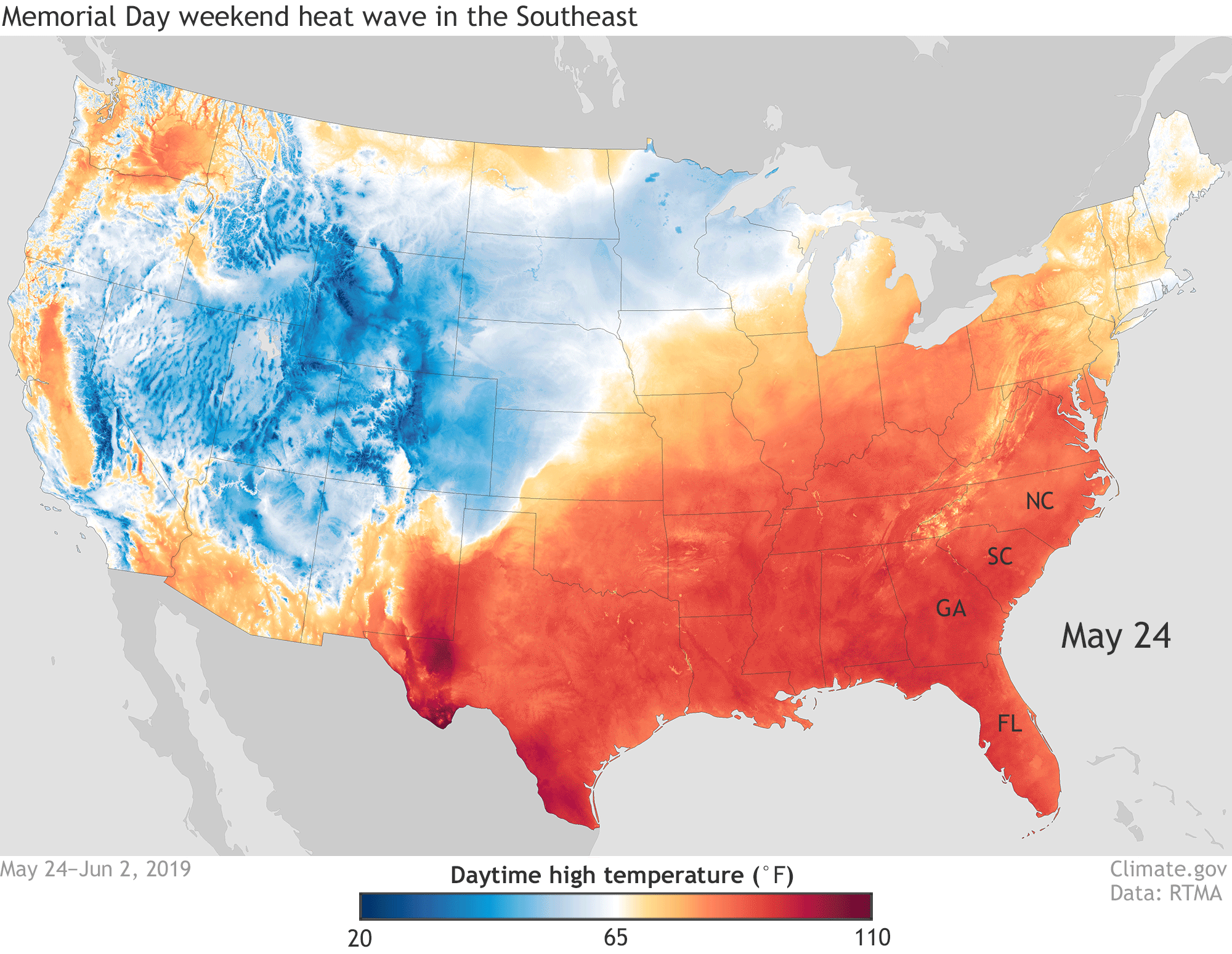Heat Waves
What are they?
Heat waves are periods of abnormally hot weather that typically last two or more days. While there is no single definition for a heat wave, they are generally determined when the temperatures exceed some threshold for a sustained amount of time. They usually have the most impacts during summer months when normal temperatures are already high. In the Southeast US, where North Carolina is located, heat waves often occur when an area of high pressure (also called a “ridge”) sits over the region for an extended period of time. When there’s a high pressure system in place, we typically experience clearer skies and fair weather. As the sun shines down, it warms the surface and, because high pressure in the atmosphere acts like a dome or a cap, that heat is trapped in place. When this weather pattern is in place for a few days in a row, our temperatures can creep up, stay high, and lead to an extreme heat event.
Consistent with historical trends, the state is projected to experience warming temperatures, especially at nighttime. The likelihood of extreme heat events is also projected to increase in the state, making extreme heat an important hazard for North Carolinians to be prepared for now and into the future.1 Rising average temperatures and more frequent and more intense heat waves due to climate change are affecting human health in several ways. Most directly, warmer average temperatures and more extreme temperatures put more people at risk for heat-related death and disease, such as heat stroke and dehydration.3

Why should I care?
There are a number of negative impacts from heat waves, including:
Heat waves can amplify the impacts of other weather and climate events, namely droughts and wildfires. When a heat wave coincides with a drought, the drought can be significantly exacerbated as the increased temperatures raise evapotranspiration rates and stress plants and animals. Heat waves, however, usually only last for a couple of days, whereas drought conditions can last for years. Forest fires are a common component in many climates, including in North Carolina, but a heat wave can increase the severity of wildfires, as well as make conditions more difficult for firefighters to work.

Power outages are possible because of the increased use of air conditioners during heat waves, especially in regions where air conditioning throughout the year is usually unnecessary. The added use puts stress on the electrical utilities because everyone turns on maximum air conditioning at the same time. The increased demand can cause substations to overheat and shut down, cutting off air conditioning to thousands of people at the time they need it most. Home air conditioners are also at risk of shutting down when subjected to hot temperatures, usually above 100°F, over many days with increased usage.

Both humans and animals can have adverse health outcomes resulting from severe heat stress, and heat waves can lead to increases in human and animal mortality if cool areas are not available. The elderly and young children heat up faster because their bodies are less able to regulate their internal temperatures, making them particularly vulnerable to prolonged heat spells. However, this does not mean other populations aren’t also at risk. In North Carolina, agricultural workers and young athletes who spend several hours a day outside are especially vulnerable to heat-related illness during heat waves. In fact, from 1992 to 2006, the annualized rate for reported heat-related deaths among crop workers in the U.S. was highest in North Carolina at 2.36 deaths per 100,000 workers.2: Additionally, for the past ten years, North Carolina has seen the greatest number of heat-related visits to the emergency department among men ages 25-64.4
In order to cool down the body, a person will sweat to release heat and provide a source of moisture for evaporation, which cools the skin surface. When the humidity is high, as is common during heat waves in North Carolina, evaporative cooling through sweating becomes less efficient. Additionally, temperatures do not cool as much at night during higher levels of humidity, exacerbating the impacts of a heat wave because the body has no relief from the oppressive conditions.
Heat stress is cumulative: as hot conditions are sustained, heat stress continues to build.
For these reasons, it is important to stay cool during heat waves. Many cities now have local air-conditioned centers where people can go to cool off as relief from the heat, and North Carolina’s Department of Health and Human Services provides aid in acquiring fans through Operation Fan and Heat Relief. During hot temperatures, if you need to work outside, you should take frequent breaks in cool areas and drink water to prevent dehydration. If you stop sweating in hot conditions, experience heat cramps, or faint, seek immediate medical attention because your body may be overheating, leading to heat exhaustion and even death.
1Kunkel, K.E., D.R. Easterling, A. Ballinger, S. Bililign, S.M. Champion, D.R. Corbett, K.D. Dello, J. Dissen, G.M. Lackmann, R.A. Luettich, Jr., L.B. Perry, W.A. Robinson, L.E. Stevens, B.C. Stewart, and A.J. Terando, 2020: North Carolina Climate Science Report. North Carolina Institute for Climate Studies, 233 pp. https://ncics.org/nccsr
2Luginbuhl, RC; Jackson LL; Castillo DN; Loringer KA. heat-related deaths among crop workers — United States, 1992—2006. MMWR 2008;57(24);649-653. <http://www.cdc.gov/mmwr/PDF/wk/mm5724.pdf> Accessed February 17, 2021.
3Portier CJ, et al. 2010. A human health perspective on climate change: a report outlining the research needs on the human health effects of climate change. Research Triangle Park, NC: Environmental Health Perspectives/National Institute of Environmental Health Sciences. doi:10.1289/ehp.1002272 <www.niehs.nih.gov/climatereport> Accessed February 17, 2021.
4North Carolina Division of Public Health, Occupational and Environmental Epidemiology. The 2020 North Carolina heat report. <http://publichealth.nc.gov/chronicdiseaseandinjury/doc/HeatReport20-2012.pdf> Accessed February 17, 2021.